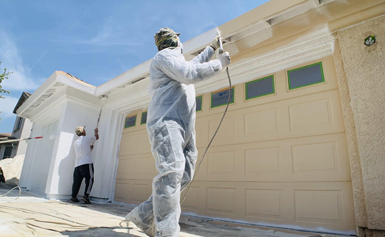When you first look at a home, the exterior tells a silent story. It shares years of sun, seasons of downpours, and countless cold snaps. And although it doesn’t scream for attention, paint takes the brunt of it all. Layer by layer, season by season, it begins to fade, peel, and crack. It happens slowly. Quietly. Yet consistently.
At first, it’s barely noticeable. A faint dullness. A small blister. A hairline crack. Then, one day, you stand back, and it’s not quite the home you remember. That’s how the weather works—patient and relentless. But understanding how it wears down paint and knowing how to stop it in its tracks can make all the difference.
The Hidden Toll of Heat, Rain, and Cold on Exterior Paint
Heat: The Slow Burn
Summer seems harmless enough, but it does more than warm the air. It expands surfaces, dries out moisture deep within walls, and makes paint brittle. Over time, heat causes:
- Fading: UV rays bleach the color, leaving walls looking worn out.
- Blistering: Trapped heat under paint causes bubbles to form.
- Cracking: As surfaces expand and contract, paint loses flexibility.
What once looked fresh begins to feel tired. Even the brightest colors start to look washed out.
Rain: The Constant Drip
Rain doesn’t need to be heavy to cause damage. Even light, steady showers chip away at a home’s surface. When moisture seeps in:
- Mildew and mold form, especially in shaded areas.
- The paint softens, making it peel away faster.
- Water stains start appearing, especially around windows and doors.
Once water finds a way in, it keeps coming back. And it doesn’t leave quietly.
Cold: The Silent Cracker
Cold doesn’t shout. It creeps in. Paint stiffens, and walls contract. When winter sets in:
- Paint becomes fragile, prone to breaking apart.
- Frost penetrates cracks, widening them with every freeze-thaw cycle.
- Surfaces lose adhesion, making paint lift off in flakes.
The surface may look intact from afar, but underneath, the damage is already growing.
Why It Matters More Than You Think
Peeling paint isn’t just about appearance. It signals deeper issues. Behind every blister or crack could be damp wood, rusting nails, or weakened brickwork.
Leaving it alone only makes repairs harder later. Moisture trapped behind paint can lead to expensive structural problems, reduced insulation, and more energy loss in both summer and winter. Your home should stand strong through every season—not just look good during one.
What You Can Do—And Why It Works
Protecting your paint doesn’t mean constant upkeep. It means smart timing and the right care. Here’s what keeps your exterior looking and lasting better.
Regular Cleaning
Dirt traps moisture and feeds mold. A simple wash every few months removes:
- Dust and debris
- Algae in shaded areas
- Pollutants that speed up wear
Mild soap and water, or a low-pressure hose, can go a long way. It’s one of the easiest steps that many skip.
Timely Inspections
Once or twice a year, walk around your home. Look for:
- Discoloration
- Small cracks or chips
- Bubbling areas
Catching issues early keeps them small. It’s far easier to touch up one wall than repaint everything later.
Repainting at the Right Time
Don’t wait until the paint is falling off. A fresh coat before major wear sets in gives stronger protection. Signs it’s time include:
- Faded colors
- Loss of smoothness
- The paint feels chalky to the touch
When repainting, choosing the right paint matters. Some are built to withstand harsh weather better, holding color and grip for longer periods.
Caulking and Sealing
Gaps around windows, doors, or siding invite moisture. Resealing these areas:
- Keeps water out
- Prevents air leaks
- Helps paint stick better
This small step adds a strong line of defense.
Trimming Nearby Trees
Branches that touch walls wear down paint with every breeze. Leaves block the sun, letting moisture linger. Keeping plants trimmed allows:
- Better air circulation
- Faster drying after rain
- Less mildew buildup
A clear buffer around your home supports the life of your exterior.
Simple Habits That Make a Lasting Difference
Caring for your home’s exterior doesn’t have to be overwhelming. It’s about small habits that build up over time.
- Clean surfaces gently every few months.
- Watch for small signs before they turn into big ones.
- Repaint when needed, not when it’s already too late.
- Keep water out with proper sealing.
- Give your walls space to breathe by trimming plants.
Each action protects more than paint. It protects the comfort and strength of your home.
Why Your Attention Matters
Your home doesn’t complain. It quietly absorbs every season. But with every coat of paint, with every bit of care, it reflects how much it matters to you. That front wall, the side fence, the trim around the windows—they carry memories. Seasons spent together, guests welcomed, moments shared.
Taking care of your home isn’t about perfection. It’s about presence. It’s about knowing that what’s outside still reflects what’s inside.
The Reward Is in the Results
When paint holds strong through heat, rain, and cold, everything feels better.
- The home stays warmer in winter and cooler in summer.
- The walls look clean, not patchy.
- Repairs cost less because problems were stopped early.
- The entire place feels more welcoming and cared for.
These aren’t just cosmetic changes. They shape how you feel every time you come home.
Final Thoughts
Weather doesn’t take breaks. But your paint doesn’t have to surrender. With attention, small habits, and smart timing, your exterior can stand tall for years.
It’s not about outsmarting nature—it’s about working with it. Let every season pass, knowing you’ve already done what truly helps. No rushing. No stress. Just quiet care that lasts.
